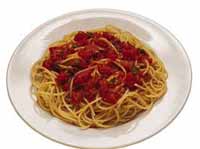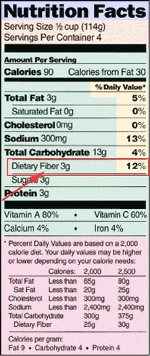Fiber
 The Functions of Fiber The Functions of Fiber
- Fiber has been referred to as nature's little whisk broom. With the help of water, fiber swells up and moves food quickly through your intestines. Can you just visualize that bran cereal clearing out all those folds and crevices in the intestinal track?
- Fiber really helps if you suffer from constipation or want to prevent a flare up of hemorrhoids. (Isn't getting older great?).
- Fiber can also help lower cholesterol and other blood fats.
- Fiber fills you up and may help you eat fewer calories when you are trying to lose weight.
- For people with diabetes, the most important function of fiber is that it slows down the rate that carbohydrates move into the bloodstream.
Although fiber is a carbohydrate, the body doesn't absorb it or turn it into sugar. In fact, high fiber foods have been shown to delay the blood sugar rise after meals. Compare beans and pasta:
1 c pinto beans = 15 grams carb and 5 grams fiber
1 c pasta = 15 grams carb and .5 grams fiber
These two foods have the same amount of carbohydrate per serving, but beans are much higher in fiber. As a result, beans don't raise the blood sugar as quickly or as much as the pasta.
 How Fiber Figures in to Carb Counting How Fiber Figures in to Carb Counting
High fiber foods have less absorbable carbohydrate and it helps to account for this when adding up your carbohydrate at a mealtime, especially if you are matching your insulin to your food intake. You can find fiber grams listed on the food label. Fiber is part of the total carbohydrate grams. It is also listed by itself under the carbohydrate grams.
EXAMPLE:
- When a food contains 5 or more grams of fiber, start by subtracting the fiber grams from the total carbohydrate grams.
- If your cereal portion contains 20 grams of carbohydrate and 5 grams of fiber (20 - 5), the amount of digestible carbohydrate in that portion of cereal = 15 grams.
- When adding up the carbohydrates at the meal, or calculating your insulin to carbohydrate ratio, you would count your cereal as only 15 grams of carbohydrate instead of 20.
How Much Fiber Do I Need?
Strive for at least 20-35 grams of fiber daily. Sources of fiber include whole grains, beans, nuts, fruits and veggies. Below is the fiber content of some foods.
| 1 small apple | 3 grams |
| 1 carrot | 2 grams |
| 1 slice 100% whole wheat bread | 3 grams |
| 1 cup bran flakes | 5 grams |
| 1 cup almonds | 4 grams |
| 1 cup pinto beans | 7 grams |
If you quickly increase your fiber intake, you might notice more gas and bloating. To avoid this, slowly add fiber to your diet. Also, remember to drink plenty of water, as fiber is like a magnet attracting water to it. If you are dehydrated, fiber could bind you up even more. It is recommended that you drink at least 8 (8 oz.) glasses of water daily.
 Continue Continue 
|





